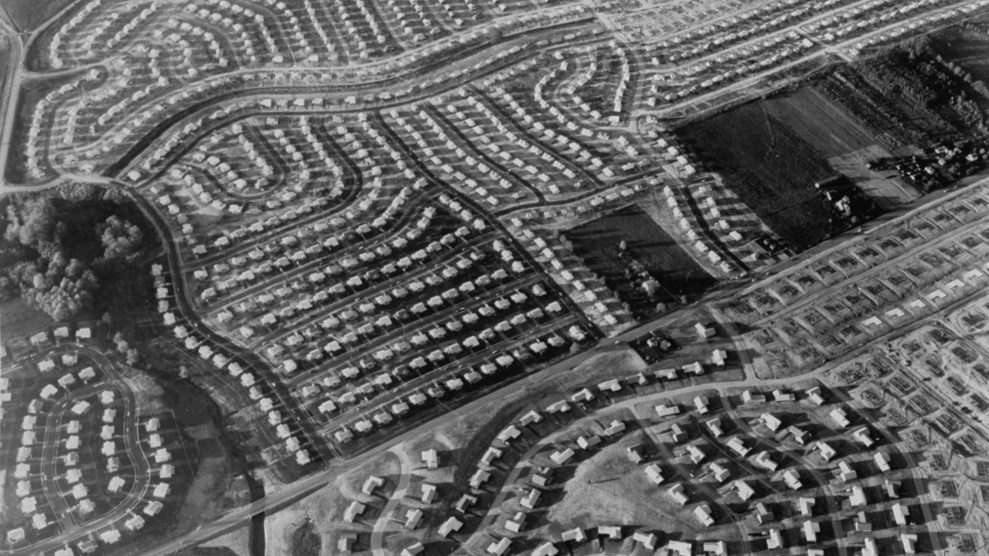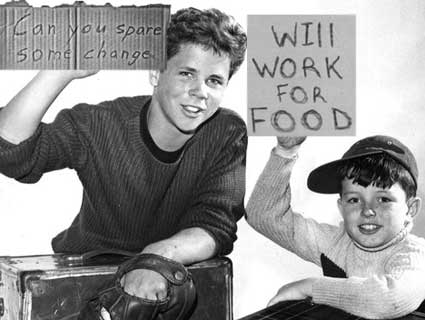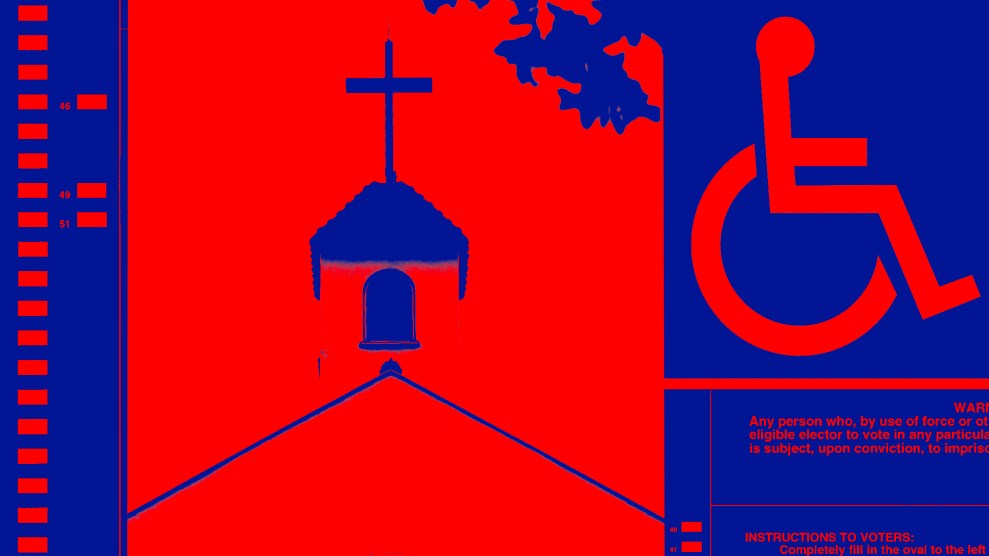
Margaret Bourke-White/The LIFE Picture Collection/Getty
The typical suburb as it is stereotyped in the popular imagination is white, wealthy, and conformist. The Monkees’ 1967 song “Pleasant Valley Sunday” captured the cliché by describing a place with “rows of houses that are all the same and no one seems to care,” where there’s a TV in every room “here in status-symbol land.”
Amanda Kolson Hurley, an editor at CityLab, author of Radical Suburbs, and resident of Silver Spring, Maryland (a suburb of Washington, DC), knows that real-life suburbia is a “dizzyingly broad category.” Her book explores the stereotypes of traditional, largely white areas oriented around single-family homes, but especially focuses on radical suburbs, including those formed by anarchists and civil rights activists. Neighborhoods are not static and neither are suburbs. I caught up with Hurley, who used to be my editor at CityLab, and talked to her about the lessons we can learn today from the radical suburbs of the past.
Mother Jones: You write that the misinformed clichés that still define suburbia in the popular imagination drive you crazy. How does your experience living in suburbs conflict with popular ideas about them?
Amanda Hurley: One of the experiences that led me to write the book was living in a suburb of DC in Maryland that’s really not at all stereotypical, despite being suburban. I was living in a neighborhood that was really dense. People took public transportation a lot. It was ethnically and racially diverse, and had a big immigrant community. It was also mainly apartments. There are a lot of suburban neighborhoods that are not just single-family houses. That experience led me to look into the history of suburbs in America. I found that there were these experimental places that were quite different from stereotypes.
MJ: How do people typically think about the history of US suburbs and why is that incomplete?
AH: A lot of people think about the big boom in development after World War II when veterans were returning home. The baby boom was getting underway and you had all these people who needed houses, but houses just weren’t being built during the war—and during the Depression. That really was a major phenomenon in spreading suburbs—and a certain type of suburb that’s very recognizable to look at—across the United States.
But there were other earlier waves of suburbanization too, that are easy to forget. The 1920s was a big period where you started to see developers building very large suburban tracts on a speculative basis. Going back to the railroads in the 1850s and 1860s, you started to see people building these kind of Villa enclaves for people who wanted to have an escape from the city. The history goes back even further than that. Suburbs aren’t particularly American. Cities throughout history have had suburbs. Ancient Rome had suburbs. Archaeologists have found evidence of suburbanization around Ur and ancient cities in the Americas had suburban areas as well.
MJ: You point out that sprawl-style land use increases greenhouse emissions by encouraging us to drive more. How do we make suburbia less car-centric and more walkable?
AH: The kind of archetypal suburb that we think of and that became very popular with large-scale homebuilders in the late 20th century is just one of a number of forms that suburbs have taken. Some of the experimental suburbs in my book have some promising lessons as models that that we could use today. For instance, these anarchists moved out to New Jersey from New York and they were not wealthy or highly skilled people when it came to building themselves a new town. They built basic cottages and expanded them over time. They were able to live in them, raise families, and grow crops or keep animals out the back. They commuted into the city when they needed to to do some work or to sell produce. Those small homes were sufficient for them. They were kind of like the original tiny houses.
Or there’s a New Deal demonstration town called Greenbelt in Maryland. That was really an attempt by planners and architects to bring European-style modern design and planning principles to the United States without detached houses. It’s all mid-rise apartment buildings and rows of several townhouses that are very space-efficient. Because the homes were arranged around these kind of green plazas, people didn’t feel crowded or crammed into the houses. They felt like they had a really nice open space and access to nature.
Bringing in transit or designing any new homes around mass transit are ways you can lessen that environmental impact of suburban development. What was so striking to me is we used to do these things. At least some suburbs used to reflect these principles. We fell away from that, but we can get back to it.
MJ: You also say that prominent architects often stigmatize suburbia. How so?
AH: There is a somewhat long tradition of architects turning their noses up at the suburbs. Suburbs are areas where it’s assumed the people are not very sophisticated, that they’re very conformist, and not interested in ‘high culture.’ There’s long been this idea among cultural elites that the suburbs are where culture goes to die. You definitely still see that today; a lot of architecture schools and architecture firms tend to operate in cities or on college campuses and college towns. Not that many architects concern themselves with the future of the suburbs.
As a whole, architecture remains more interested in the city. I find it somewhat ironic that, as some cities are undergoing really rampant gentrification, they still seem a little bit stuck in this mindset of “Gosh, we’ve got to improve these neighborhoods.” Not saying that urban improvement is a bad thing at all, but there’s also certainly great scope and need for improvements in suburban neighborhoods too.
MJ: Stelton, the anarchist colony in New Jersey you include in Radical Suburbs, had some interesting ideas about education and building communities around children. Tell me about the anarchists’ “Modern School.”
AH: The school was based on the ideas of a Spanish anarchist and educator named Francisco Ferrer. You could call it a progressive school, but it was almost a little bit closer to the kind of “unschooling” movement, which is this very self-directed model of education. Really, all the adults do is set things up, put the children on this journey of exploration and discovery—and make sure that nobody gets hurt.
The reason it was so important to [the anarchists] was that they really believed that if they educated children in a way that made them independent and freethinking, and not filled with religious instruction from this or that denomination, or filled with patriotic instruction, they would have children who would be better equipped as people, leaders, and participants in society. It was quite an unusual model, but they did attract certainly children or families from quite a wide area around them who would send their children to the school.
MJ: You spoke to one of the Modern School’s former students who grew up in Stelton in the 1930s and 1940s. What did Jon Thoreau Scott say?
AH: Like a lot of the kids who went to the school, he did not learn to read until he was 10 or 11. They did not try to force kids to read or steer kids to read. What the adults in the community found was that usually around that age, children would naturally show a curiosity about reading and ask for someone to help them. It certainly didn’t hamper his education; he became a professor of atmospheric science.
MJ: What did you learn about co-housing or group housing?
AH: I write about a religious commune outside of Pittsburgh in the early and mid-19th century, founded by a quite unusual group called the Harmonists who had left Germany under religious persecution to come to Pennsylvania. These were very thoughtfully built and designed communities, but they had an unusual way of life in that they were celibate—at least at the time in their history that I write about them. They tended to live in group house type of arrangements. They built small houses that would be similar to the houses in other towns and cities, but it wouldn’t be a nuclear family in each house because they stopped having nuclear families when they embraced celibacy. You would have maybe two unrelated women living with two unrelated men as roommates and they would each have prescribed tasks, and presumably care for one another when they were sick.
It shows us that these suburban communities did exist that made space for and even privileged people who were not married or did not have children. The sort of “Leave it to Beaver” paradigm is not the full story of the suburbs at all.
MJ: How did Concord Park in Pennsylvania and Reston in Virginia succeed with racial integration?
AH: You had this model of the entirely white, large, homebuilder suburb that was spreading across the country at the time. I find Concord Park so interesting because very early on, there was a civil rights activist who thought, “I’m going to mount a challenge to this. I’m going to show that you can build a suburb that looks entirely similar to the Levittowns of the world. But it’s going to be fully integrated.” It’s just extraordinary how difficult it was for him to pull that off, but perhaps more extraordinary was that really he did in the end.
In terms of Reston, that was a little different from Concord Park in that it was less deliberate. The developer of Reston said, I’m not going to tell anyone they can’t live here. Even though Reston was so far away from everything in the DC area at the time and it was a very inconvenient location, it quickly developed a relatively large, active, and close-knit African American community. I think that was because there were just so few places where African Americans at the time could just go buy a new house. One of the residents I interviewed said she had gone to a different suburb, and she and her husband offered to buy a house outright with no mortgage, and they were still refused because they were black. She hated that Reston was in Virginia and she hated how far away it was, but she saw that it was open and that she would not be the only black family there. She’s still living there, decades later.
MJ: How did Greenbelt, Maryland, built as part of the New Deal, fail with integration?
AH: Greenbelt is sort of this paradox in a way. It was public housing in the suburbs. The idea was that you could build very high-quality housing for people who did not have a lot of money, and the hope was that this was a model that could spread all over the country. There was so much that was progressive about Greenbelt: Initially, it had a progressive elementary school with very forward-thinking curriculum. It prioritized people being able to walk. It had a lot of cooperative enterprises, another big focus. But only white people were allowed to apply to live there when they had the tenant selection. So it was blatantly racially exclusionary. It’s quite shocking, but it was actually quite in keeping with a lot of the New Deal programs that underlined racial discrimination at the same time that it was advancing other goals.
MJ: You end the book by writing, “Suburbia is what we make it.” How did the research you completed for this book inform that conclusion?
AH: It became clearer and clearer to me that people get—about a lot of things, but especially about suburbia—very fatalistic. There’s an idea that there’s just the way that the suburbs are, and that is sort of a default, that they’re kind of inherently conservative or unimaginative or bland or bad.
But nothing is preordained, right? If suburbs are like that in certain respects, it’s the result of choices and forks in the road and policies over decades and centuries. At all of these points in the past, there were alternatives. Some of those alternatives are still around and you can go visit them and even live in them and see how things could have turned out differently. Going to these places and seeing what works about them shows that we can still bring some of their qualities and some of those features into the suburbs of the future, which I think would be really exciting.
This interview has been edited for length and clarity.
















